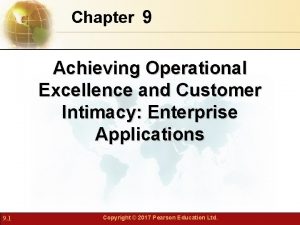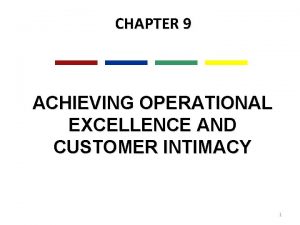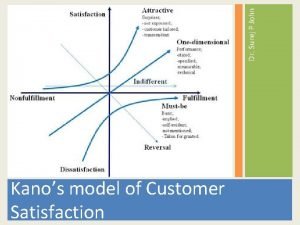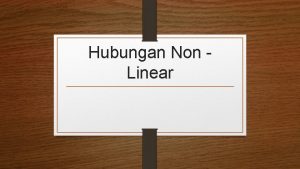QUALITY MANAGEMENT Kanos Model of Non Linear Customer









- Slides: 9

QUALITY MANAGEMENT Kano’s Model of (Non. Linear) Customer Satisfaction Satisfied Delighter (D) Linear Satisfier (L) or Performance Requirement Not Fulfilled Indifferent (I) Requirement Fulfilled Time Customer Not Satisfied Must Have (M) or basic Needs Prof. Indrajit Mukherjee, School of Management, IIT Bombay 1

QUALITY MANAGEMENT Market Dynamics and the Kano Model ce an m or rf pe ar d an d Y T I D O St “Delighters” move to “Must Be” features over time! Customer Satisfaction e c I T an A V m r O N fo r N I pe ce n ip a h m s r r e o f d r a e e Execution Excellence p L ve i t ti e p m Co VE M O C M Prof. Indrajit Mukherjee, School of Management, IIT Bombay 2

QUALITY MANAGEMENT “House of the Quality” Quality Function Deployment Voice of the Engineer Voice of the customer correlations Competitive Analysis Technical Comparison Prof. Indrajit Mukherjee, School of Management, IIT Bombay 3

QUALITY MANAGEMENT Designing for the Customer: The House of Quality Car door Design Engineering Correlation: ∆ Strong Positive o Positive X Negative * Strong Negative X X X Door seal Energy Needed Ground energy Water Account. Trans. to Close Door Needed to resistance on level Window open door Characteristics resistance Check force Imp orta Cust. nce to X=Us A=Comp. A B=Comp. B (5 is Best) 1 2 3 4 Customer Requirements Customer requirements information forms the basis for this matrix, used to translate them into operating or engineering goals Easy to close 7 Can open on a hill 5 Easy to open 3 Doesn’t leak in rain 3 No road noise 2 x AB A x. B x Importance Weighting 10 6 6 9 2 3 Target Values Technical Evaluation (5 is Best) 5 5 4 3 2 1 B A x B XA BA A B Relationships: ∆ Strong=9 o Medium=3 * Small=1 X A Prof. Indrajit Mukherjee, School of Management, IIT Bombay 4

QUALITY MANAGEMENT Customer-Driven Quality cycle Customer needs and expectations (expected Quality) Identification of customer needs Translation into product/service specifications (design Quality) Performance/Output (actual quality) Customer perceptions (Perceived quality) Measurement and feedback PERCEIVED QUALITY = ACTUAL - EXPECTED Prof. Indrajit Mukherjee, School of Management, IIT Bombay 5

QUALITY MANAGEMENT The Engineering Method and Statistical Thinking Develop a dear description Identify the important factors Propose or refine a model Manipulat e the model Confirm the solution Conclusion and recommendations Conduct experimen ts Prof. Indrajit Mukherjee, School of Management, IIT Bombay 6

QUALITY MANAGEMENT Median • Not affected by extreme values 0 1 2 3 4 5 6 7 8 9 10 Median = 3 • In an ordered array, the median is the “middle” number – If n or N is odd, the median is the middle number – If n or N is even, the median is the average of the two middle numbers Prof. Indrajit Mukherjee, School of Management, IIT Bombay 7

QUALITY MANAGEMENT Variation Measures of variation give information on the spread or variability of the data values. Same center, different variation Prof. Indrajit Mukherjee, School of Management, IIT Bombay 8

QUALITY MANAGEMENT Data Summary and Display How Does the Sample Variance Measure Variability? 12 13 14 x 2 x 8 x 1 x 7 x 4 15 x 3 x 6 x 5 Figure How the sample Variance measures variability through the deviations Prof. Indrajit Mukherjee, School of Management, IIT Bombay 9















